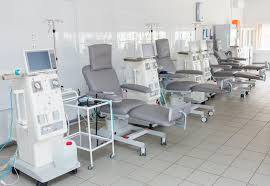Global Dialysis Market Size and Share Analysis – Growth Trends and Forecast Report 2025–2033
Executive Summary
The Global Dialysis Market is projected to reach US$ 171.61 Billion by 2033, growing from US$ 116.57 Billion in 2024 at a CAGR of 4.39% from 2025 to 2033. The market growth is primarily driven by the rising burden of chronic kidney disease (CKD) and end-stage renal disease (ESRD), the aging global population, increasing prevalence of diabetes and hypertension, technological innovations in dialysis devices, and expanding access to home-based dialysis solutions.
Download Sample & Read More: https://www.renub.com/request-sample-page.php?gturl=global-dialysis-market-p.php
What is Dialysis?
Dialysis is a life-saving procedure that substitutes for the kidneys when they lose their function. The process removes waste products and excess fluids from the blood, which the kidneys would typically handle. The two primary types of dialysis are:
- Hemodialysis (HD): Blood is filtered outside the body using a dialysis machine and dialyzer.
- Peritoneal Dialysis (PD): Utilizes the peritoneal membrane inside the abdomen as a filter, introducing dialysis solution to remove toxins.
Though dialysis doesn’t cure kidney failure, it enables patients to maintain electrolyte balance and survive until a kidney transplant is available.
Market Drivers
- Rising Burden of CKD and ESRD
CKD is increasingly common due to the global surge in diabetes and hypertension. ESRD demands long-term dialysis or a transplant. According to NIDDKD, 786,000 Americans were living with ESRD in 2021, with 71% on dialysis. CKD prevalence continues to grow globally, intensifying demand for dialysis services.
- Aging Global Population
As per demographic forecasts, the percentage of people aged 65 and above is expected to grow from 10% in 2024 to over 16% by 2050. Since elderly populations are more prone to kidney issues, this demographic trend is a strong driver of market expansion.
- Technological Advancements
The dialysis industry is witnessing innovations such as:
- Wearable artificial kidneys (e.g., patent by Victor Gura in 2021)
- Portable home dialysis machines
- Smart monitoring tools enhancing patient adherence and reducing complications.
- Growth in Home-Based Dialysis
The rising preference for home dialysis—including APD (Automated Peritoneal Dialysis) and CAPD (Continuous Ambulatory Peritoneal Dialysis)—is significantly changing the market landscape. These methods offer flexibility, convenience, and better quality of life, especially in developed markets.
- Expansion of Private Clinics
Countries like India have seen a surge in private dialysis clinics, enhancing access to customized, advanced care. Private facilities offer flexibility, technological innovation, and help reduce pressure on public systems, especially in resource-limited settings.
Market Challenges
- High Cost of Treatment
Dialysis is expensive due to the need for ongoing treatments, specialized equipment, and skilled personnel. This becomes a major barrier, particularly in low- and middle-income countries and areas with limited insurance coverage.
- Patient Compliance and Quality of Life
Dialysis significantly impacts patients’ routines and mental health. Frequent hospital visits, side effects like fatigue and infections, and strict dietary restrictions make long-term compliance challenging. Poor adherence affects treatment outcomes and limits market growth.
Regional Insights
North America
- United States dominates due to a large aging population, high CKD prevalence, and advanced infrastructure.
- Both in-center and home dialysis are growing.
- Strong presence of companies like Fresenius and DaVita supports market growth.
Europe
- Countries like Germany and the UK lead with robust reimbursement systems and technological integration.
- Increasing shift toward home-based peritoneal dialysis to reduce healthcare burden.
Asia-Pacific
- India and China are witnessing rapid growth due to rising CKD incidence and improving healthcare access.
- India is a hub for private dialysis centers, especially in urban areas.
- Government programs and startups are innovating low-cost dialysis.
Latin America & Middle East
- Brazil, Mexico, Saudi Arabia, and UAE are investing in dialysis infrastructure.
- Saudi Arabia’s government is expanding healthcare access, especially for chronic diseases.
Africa
- Faces infrastructure and affordability challenges.
- Slow growth due to limited awareness and underdeveloped systems.
Market Segmentation
By Type
- Hemodialysis
- Peritoneal Dialysis
By Product & Services
- Services
- Equipment
- Consumables
- Drugs
By End User
- Home Dialysis
- In-Center Dialysis
By Countries
North America:
United States, Canada
Europe:
France, Germany, Italy, Spain, United Kingdom, Belgium, Netherlands, Turkey
Asia-Pacific:
China, Japan, India, South Korea, Thailand, Malaysia, Indonesia, Australia, New Zealand
Latin America:
Brazil, Mexico, Argentina
Middle East & Africa:
Saudi Arabia, UAE, South Africa
Competitive Landscape – Key Players
Major companies driving innovation and market competition include:
- Asahi Kasei Corporation
- B. Braun Melsungen AG
- Baxter International Inc.
- Becton Dickinson and Company
- DaVita Inc.
- Fresenius Medical Care AG & Co. KGaA
- JMS Co. Ltd.
- Medtronic Plc.
Each key player is analyzed based on:
- Company Overview
- Key Executives
- Product Portfolio
- Recent Developments & Strategies
- Revenue Analysis
Conclusion
The Global Dialysis Market is evolving rapidly with growing disease burden, technological advancements, and policy support. While challenges like affordability and compliance remain, the trend toward home-based care and innovation in portable, wearable devices will significantly shape the next decade. Emerging economies and public-private partnerships are expected to play a vital role in democratizing access to dialysis worldwide.






